
Contact us 01889 597 283 | contact@oaktimberstructures.co.uk
Contact us 01889 597 283 | contact@oaktimberstructures.co.uk
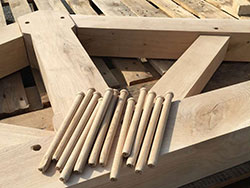
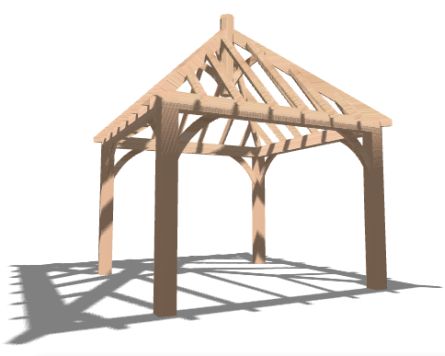
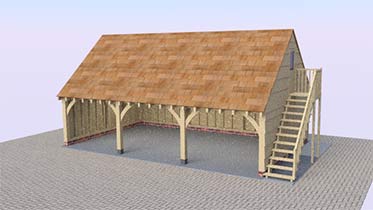
Does a gazebo or pergola need footings?
We get asked this a lot. We understand, after all, you want your oak timber structure to be as solid and last as long as possible.
Problem is. The internet is full of contradictions with this dilemma. So it’s hard to know right from wrong.
It’s time to resolve the footings debate once and for all. Whether it's gazebo footings or pergola footings, you'll find answers in this article. You’ll learn your options, and if you need them at all!
To dig or not to dig, that’s the question. Let’s look.
A gazebo is a free-standing garden structure. Fitted with a roof, it offers shelter from the elements. Gazebos come in different shapes and sizes.
From dining areas to a private spot for a hot tub or simply a tranquil environment to sit, a gazebo offers a secluded focal point within your garden.
At Oak Timber Structures, we create each gazebo bespoke to your sizes and requirements. Want to know more? Check out our gazebo page.
A pergola uses the same superstructure as a gazebo but instead of a roof, the top of the structure features horizontal crossmembers, offering an appealing and open aesthetic. You can leave the roof rafters uncovered, covered, or a popular option is customers often use the rafter grids as a trellis for vines.
Pergolas are freestanding or can stand flush against an existing building. Pergola’s integrated into an existing structure are called lean-tos, you can buy lean-tos online.
For more information, check out our pergola page where you can use the 3D designer to create a bespoke pergola to your specs.
So you want a gazebo or pergola? Before ordering and beginning assembly, you’ll need to select the location where it’ll stand. Here are some things to consider:
Sounds basic, right? But it's easy to get caught up in designing and forget to confirm measurements. Use a tape measure and peg out the footprint of the pergola or gazebo.
Once you've mapped the footprint, you can assess whether you're happy with the position. Make sure that not only there’s ample space but also avoid large tree trunks should you need to dig.
Consider the sun's movement. Do you want exposure to the sun? Do you want to watch the sunset?
When you think you’ve found the place, you can inspect the terrain.
It's important to make sure the foundation is stable. So what’s the best foundation type for a gazebo or pergola?
Stability starts at ground level, so you need to make sure the area is flat. If uneven, how easy is it to level?
Levelling is as simple as moving high spots to the lower areas. You can do this using a spade to distribute soil evenly. This will make for easy assembly while improving the stability of the structure.
Does standing water gather in your desired location? A boggy terrain isn't ideal and can cause the structure to subside during heavy rainfall.
Regardless of size, oak is very heavy due to its high density and moisture content and will simply sink if placed on grass with no additional support.
It's a different proposition with a pergola. Due to a lack of roof, most pergolas are lighter so often stand stable on grass provided the area is level.
Always consult a professional builder. Each gazebo and pergola vary in size and as such, weight. Not to mention your garden terrain is unique. So, a builder can cater to your specific scenario.
So let's discuss the footing options. Here’s a list of popular choices and we'll talk about the pros and cons of each.
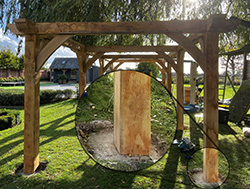
A standard 4x4m gazebo with 200mm posts from Oak Timber Structures weighs approx two tonnes. So each post supports 500kg of weight.
A common course of action is concrete pads. A pad measuring 60cm wide, 60cm in length, and 60cm in depth is adequate for each individual post. You can then fix different types of footings to the pads. Or simply, sit the posts on top.
Let's say you've got concrete pads. A practical footing method is to use Bolt-Down Post Supports.
To use such metal shoes, you'll need to fix the post supports by drilling into the concrete pads. The upright posts then slide snug into the shoes.
This is a DIY-friendly solution that protects the bottom part of the posts. The problem with metal shoes is their susceptibility to rust.
Here's another choice you can use alongside concrete pads. Stainless steel Re-bars, with a diameter of approx 20mm, can be enough to act as footings.
You'd cement these into the concrete pads or affix them into existing slabwork/foundations. Then drill a hole into the bottom of the gazebo posts long enough to ensure the post isn’t resting on the bar and then lower the posts onto the rebars.
It’s important to note that these bars are intended to stop the posts from kicking out as the oak weathers, not to lift or raise the structure in any way.
The problem is, to the attentive eye this method is somewhat unusual and untidy. The posts will appear not flush to the ground.
Here's the thing. You don't need footings!
The weight of our gazebos is enough to keep the structure stable and in place, even during high winds.
Nevertheless, with no footings, you need to make sure the area on which it stands is appropriate and there is some method to secure the posts to prevent them kicking out.
An existing patio space could hold the answer. Patios, whether slabbed, paved, or decked, often have a solid and flat base.
When builders lay slabs and pavers, they'll have prepared the ground with a layer of hardcore below. This is a solid foundation and adequate for a gazebo. But remember, check with your builder first.
Decking is a touch more difficult because the spacing of support beams needs to be strong enough to hold the weight. Chances are you won't know the strength of your decking, so, for pure peace of mind, paved and slabbed sections are better for this reason.
Besides, a paved or slabbed area makes for a stylish site to entertain underneath a gazebo.
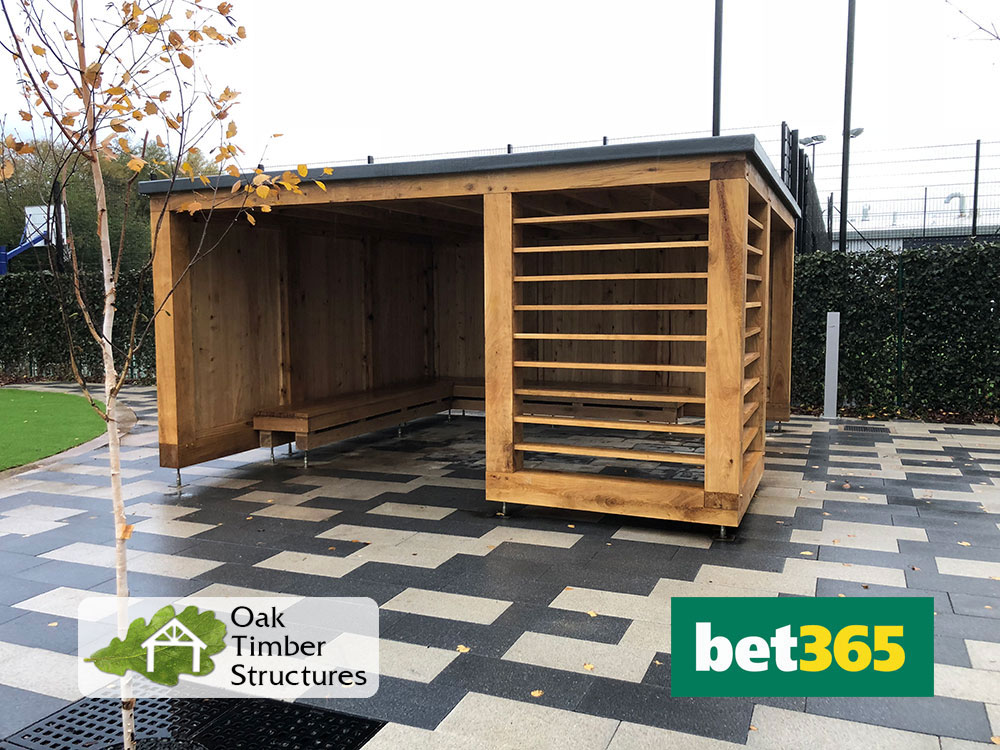
A trick of the trade, builders create a slight gradient when laying pavers and slabs. This is to make sure water runs off. Still, during heavy rainfall, or if the gradient isn't enough, standing water can form.
So, to elevate the posts from water, you can use Simpson Strong Ties for each post.
By lifting the structure 1 inch above the ground, they keep it away from weather and water so reducing the potential for decay.
Moreover, they look uncluttered and keep the natural aesthetics of the oak structure. Simpson Strong Ties can be finicky to install if you're not savvy, but a builder will find them easy to lodge.
On our website, we give you the choice to add an extra 600mm to upright posts to place into soil or concrete.
First, let’s look at placing posts into the soil.
It's a straightforward method to stabilise an oak pergola or gazebo. The method involves digging holes for each post and planting them directly into the soil. By filling soil around the posts there’s added stability.
That doesn’t mean you avoid cementing though! There should still be a concrete base for the oak posts to stand on or be set into.
Furthermore, as wood shrinks, it's relatively trouble-free to keep on top of maintenance. Just throw in some more soil and compress it around the post, better yet, use postcrete.
That said, planting into the ground won't offer the same stability as other options and there's an added expense of extra wood.
But the biggest downside of a post into the ground foundation is the lifespan. This technique exposes posts to water content in the soil. This causes decay, meaning the lifespan of the gazebo is approx 15-25 years.
This footing choice requires you to dig a hole for each upright beam. In the hole, you pour concrete. To make it neat, you can use a Sonotube. Using quick-dry concrete speeds up the drying.
As discussed, you can rest the upright beams on top once dry. Yet, you may want to plant the beams into the concrete before it dries. For this technique, you’ll need an additional 600mm on upright posts.
If performed with accuracy, the positives of this technique are that the footings are sturdy. That's why this technique is often used for larger gazebos in public spaces.
But it's not without issues. If you don’t have building experience, the technique can be difficult to master.
The problem is that posts won’t move once the concrete is dry. That’s fine if your spirit level shows an acceptable reading. But, without careful attention, posts can ride to the side. Then, you’re in trouble. You'll be on a salvage mission with a pneumatic drill, something you don't want happening.
Another negative is that wood shrinks during drying. The shrinkage can leave a gap between wood and concrete for water to gather, thus decreasing the lifespan of the oak gazebo.
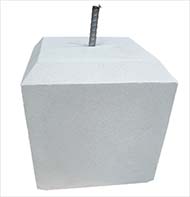
A staddle stone is a non-porous block that a pergola or gazebo sits on.
They're easy enough to fix. A staddle stone has a steel protrusion at the top and by drilling a hole in the bottom of the posts the gazebo sits on the stones.
Staddle stones are an easy way to protect upright posts and offer a distinctive aesthetic. With posts lifted off the ground, they’re away from standing water so further the lifespan.
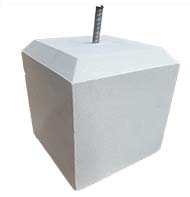
Even when left untreated, a gazebo on staddle stones lasts 30-40 years with ease. This is substantially more when compared to post into the ground foundations that’ll last around 15-25 years.
Likewise, if you want a pergola on grass, staddle stones are simple yet effective footings.
However, expect them to encounter tannin stains. Tannins are acidic chemicals held in liquid sap. As water evaporates from oak, it discharges tannins that leave brown streaks.
These tannins will drip onto the staddle stones. But it's a natural occurrence and they're simple to clean. If water and a cloth don't do the job, warm water and oxalic crystals will make light work of the stains.
In conclusion, choosing the right foundation for your gazebo or pergola depends on how much weight it needs to support. For help, you can always contact us with specific questions. Or, speak to your builder who'll assist.
How do we make life easy at Oak Timber Structures? First off, we build our bespoke gazebos and pergolas to the highest standards using only the best quality oak. So you can buy, safe in the knowledge that it's built to last. Furthermore, we'll specify the exact weight of a gazebo and pergola once ready. This way, you can prepare the foundations before arrival.
As pergolas are lighter, they're much more versatile and can sit on grassy areas. But, whatever foundation type for gazebo or pergola, make sure the ground is flat.
With location sorted, there are several options each with pros and cons. Some need more work than others and involve digging and concrete. This isn't a necessity.
If you've got existing patio space, then you're onto a winner. The tried-and-true setup of a paved patio with a gazebo sat on staddle stones is timeless. It's pleasing to the eye, stable, and will improve the lifespan of the structure.
That said, have you not got a patio, and don't fancy building one? Then, concrete pads could be the answer. You'll only need pads underneath each beam. Usually, concrete pads 60cm wide, 60cm in length, and 60cm in depth do the job for each post.
On top of the pads, fixing post supports or staddle stones can further stabilise a gazebo and is a suitable foundation that’ll increase lifespan to boot.